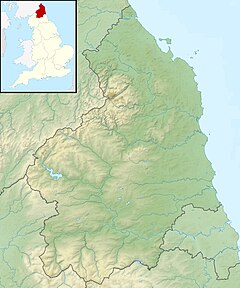Coldstream Bridge
| Coldstream Bridge | |
|---|---|

The bridge over the River Tweed at Coldstream
|
|
| Coordinates | 55°39′14″N 2°14′31″W / 55.654°N 2.242°WCoordinates: 55°39′14″N 2°14′31″W / 55.654°N 2.242°W |
| Carries | Road traffic |
| Crosses | River Tweed |
| Locale | Northumberland, England/ Scottish Borders, Scotland |
| Heritage status | Grade II* listed |
| Characteristics | |
| Material | Sandstone blocks |
| History | |
| Architect | John Smeaton |
| Engineering design by | Robert Reid |
| Construction begin | 1763 |
| Construction end | 1767 |
| Construction cost | £6,000 |
| Statistics | |
| Daily traffic | Single carriageway |
| Toll | No |
|
|
|
Coldstream Bridge, linking Coldstream, Scottish Borders with Cornhill-on-Tweed, Northumberland, is an 18th-century Grade II* listed bridge between England and Scotland, across the River Tweed. The bridge carries the A697 road across the Tweed.
The architect for the bridge was John Smeaton (responsible for the third Eddystone Lighthouse), working for the Tweed Bridges Trust. Construction lasted from 1763 to 1767, when it opened.
The cost of the bridge was £6,000, with government grants available for the project and the shortfall covered by a mixture of local subscription and loans from Edinburgh's banks, which were to be paid back by the tolling system. There was controversy when the project's resident engineer, Robert Reid of Haddington, used some of the funds to build accommodation for himself, but the trustees were assuaged when Smeaton argued that the house would actually help support the bridge. It seems that Smeaton was sympathetic to Reid, believing him to be underpaid for his work.
The bridge underwent subsequent work, including the 1784 construction of a downstream weir as an anti-erosion measure, concrete reinforcement of the foundations in 1922, alterations in 1928, and major work in 1960–1961 to strengthen the bridge and widen the road.
A plaque on the bridge commemorates the 1787 visit of the poet Robert Burns to the Coldstream. Of historical note is the toll house on the Scottish side of the bridge, which became infamous for the runaway marriages that took place there, as at Gretna Green, hence its name, the 'Wedding House' or 'Marriage House'. It ceased to be a toll bridge in 1826.
...
Wikipedia

